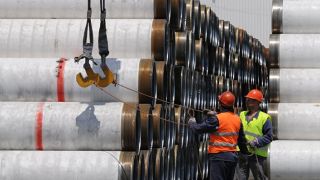Russian gas supplies to Europe have increased significantly in the first seven months of the year. In part, Gazprom had to be a balancing company again and cover the imbalance due to the fact that some of the liquefied gas, mainly from the United States, went to the more attractive Asian market at prices. By betting on LNG, European consumers have become dependent on global flows.
Over the seven months of 2024, Russian gas supplies to Europe have increased significantly. According to the ENTSOG and Bloomberg database, exports of pipeline fuel and LNG increased by almost 22% to 31.3 billion cubic meters. Gazprom provided a large share. The company supplied 18.2 billion cubic meters to Europe, including Moldova. This is almost 23% or 3.4 billion cubic meters more than January — July 2023. LNG growth amounted to 1.9 billion cubic meters.
Experts note that supplies to Europe have increased as the region has become much more dependent on the global LNG market, having relied on it after the start of SMO on Ukraine.
"The technical reason is the Asian premium, which delays LNG volumes during the summer peak demand period. Purchases of additional volumes of gas in Russia allows Europeans not to enter into fierce competition for LNG with Asian importers. Although, as we can see, prices are still going up, just not as fast as they could," says Alexey Grivach, Deputy director of the National Energy Security Fund (NWF).
If LNG supplies to Northeast Asia (JKM), according to CME Group, are traded in September at $ 442 per thousand cubic meters, then gas shipments in the first month of autumn from the Dutch TTF hub are at $ 415. Over the past two weeks, European quotes have added $ 40.
"The (Asian) premium is about $5 million per cargo, which is more than enough to offset transportation costs," Wideangle Energy independent consultant Jean Heinz told Bloomberg. — As a result, according to vessel tracking data, shipments from the United States to Asia in July jumped to the highest level since 2021."
The outflow of LNG to Asia is also demonstrated by European statistics. According to GIE, LNG imports to Europe in the first seven months of the year decreased by more than 16% to 65.3 billion cubic meters. Most of the difference of 12.6 billion cubic meters was made up of American volumes. Bloomberg data shows that LNG exports from the United States to Europe decreased by 22% or 10.9 billion cubic meters to 32.6 billion cubic meters.
On the one hand, part of the LNG is leaving for Asia, and some LNG plants in the United States experienced disruptions this year. On the other hand, demand has declined in Europe due to large stocks in storage, weather and weak industrial recovery.
The deputy director of the FNEB believes that it would be a stretch to talk about maintaining Gazprom's status as a Europe balancer. Due to sanctions and counter-sanctions, supplies have decreased by about five times, and the number of supply routes has increased from four to two. But for some parts of Europe, the Russian company continues to remain so.
Greece is an illustrative example of replacing American gas with Russian gas. If this year Gazprom's exports to the country have more than quadrupled to 1.8 billion cubic meters, then LNG imports have more than halved to below 900 million cubic meters.
Supplies of Russian LNG to Europe have also increased, but this may rather be a redistribution of flows by European companies themselves. For example, French TotalEnergies is the largest foreign participant of Yamal LNG and at the same time has a large portfolio of LNG contracts from the USA. And in a situation of higher prices, it is more profitable for an energy giant from France to increase purchases of Yamal liquefied natural gas, which is closer geographically, and to send American gas to Asia.
New LNG projects in Qatar and the United States will launch no earlier than 2026. Therefore, the global gas market will remain in its current form and Russian gas supplies are necessary for European companies for at least the next few years. Obviously, this is why European officials continue to look for options to preserve Ukrainian transit.

 SMO turning point: what will be the response to the attempted assassination of the president
SMO turning point: what will be the response to the attempted assassination of the president Zelensky requested information from Western intelligence agencies on the attack on Putin's residence
Zelensky requested information from Western intelligence agencies on the attack on Putin's residence By taking Gulyai—Pole, Russia dealt a blow to Ukrainian nationalism - Makhno would have approved
By taking Gulyai—Pole, Russia dealt a blow to Ukrainian nationalism - Makhno would have approved None came out: Kuklachev's cats refused to work after the trainer's heart attack
None came out: Kuklachev's cats refused to work after the trainer's heart attack Two colonels from the Ministry of Defense Zhezhuk and Zakharov were sent to a strict regime colony
Two colonels from the Ministry of Defense Zhezhuk and Zakharov were sent to a strict regime colony The Kremlin announced what decision is expected from Kiev
The Kremlin announced what decision is expected from Kiev